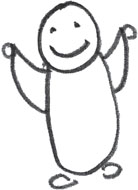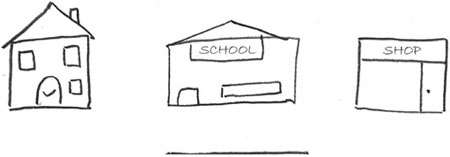
CHAPTER 3
Stick Your Toe in the Water
So, drawing is merely a means to achieve your end – which is to reduce fear and uncertainty in your child. The message is what’s important.
Yet you need to practice using the tools. For this, all you need is:
•Some sheets of plain paper (A4 minimum but for practice, A3 is best)
•A pencil (‘B’ grade with a decent point).
Most of us tend to grip tight when writing but, when drawing, hold the pencil as lightly as you can. Don’t force it on the page. Coax it round, like so:

if you’re drawing a circle.
When you draw a line it doesn’t need to be unbroken or heavy.

EXERCISE
•Draw all the individual parts of your human figures. One entire page.
•Next put them together to construct an actual figure. One entire page.
Keep your pencil motion light and easy. No heavy pressure, let it flow.
This is a practice session, so don’t waste time erasing any supposed mistakes. Cover your page in circles, lines and dots until you can do these without thinking. Just imagine you’re doodling on a notebook – it’s no different.
Now let’s think about some other components.
Human emotions
We shall want to convey some basic emotions such as happy, sad, excited or upset. Here are some ways to do these:

Mouth up (happy), mouth down (sad).

Excited – two foot bounces with a line for the ground. With the appropriate up/down mouth this can convey joy or anger.

Tearful – comma style teardrops.

Shouting/tantrum – radiating lines, open mouth.

Movement

Running – front foot pointing diagonally upwards, back foot straight down. Motion lines after moving person/object.

Hailing/greeting – arms raised.

Places
Home, school, cinema, church, shop, you name it – most need little more than a square or rectangle and a descriptive word.

Destinations
You’ve seen them in comics. A single word written on a thick arrow says we are travelling towards ‘school’. Embellish it if you like with a vertical post and ground line.

Other living things and toy animals
John’s favourite toy, without which he never travels, is a soft rabbit named Bunny. When I draw Bunny, then, like John does, I look at him as another person – just one with longer ears:

Objects
Vehicles are a must of course, but they needn’t be much more than rectangles with circles in the case of a car:

…or indeed a train.

EXERCISE
Draw:
•A page full of the following emotions: happy, sad, angry, upset
•A page full of running, jumping figures conveying those emotions
•A page full of the places, objects and destinations that mean most to your child (you’re the best judge).